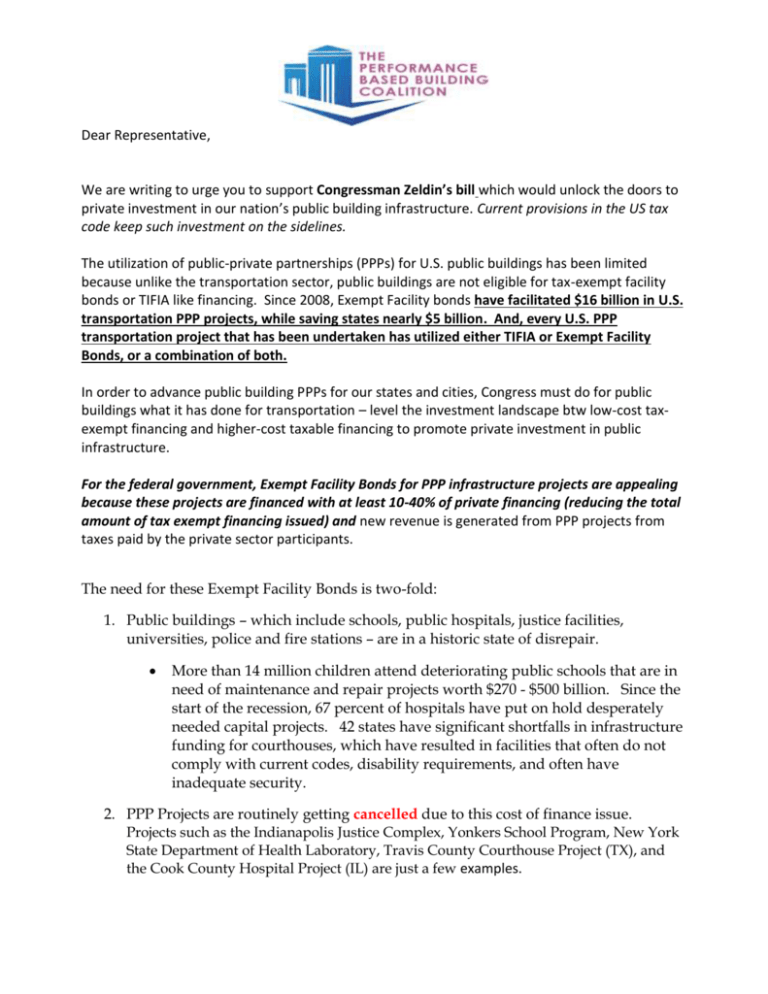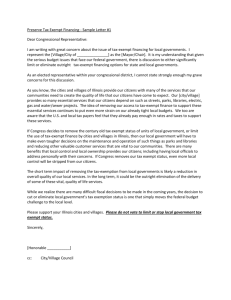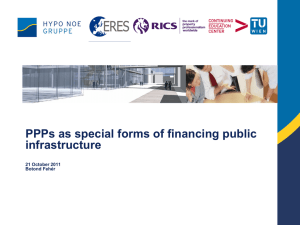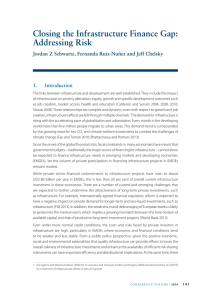a general letter of support
advertisement

Dear Representative, We are writing to urge you to support Congressman Zeldin’s bill which would unlock the doors to private investment in our nation’s public building infrastructure. Current provisions in the US tax code keep such investment on the sidelines. The utilization of public-private partnerships (PPPs) for U.S. public buildings has been limited because unlike the transportation sector, public buildings are not eligible for tax-exempt facility bonds or TIFIA like financing. Since 2008, Exempt Facility bonds have facilitated $16 billion in U.S. transportation PPP projects, while saving states nearly $5 billion. And, every U.S. PPP transportation project that has been undertaken has utilized either TIFIA or Exempt Facility Bonds, or a combination of both. In order to advance public building PPPs for our states and cities, Congress must do for public buildings what it has done for transportation – level the investment landscape btw low-cost taxexempt financing and higher-cost taxable financing to promote private investment in public infrastructure. For the federal government, Exempt Facility Bonds for PPP infrastructure projects are appealing because these projects are financed with at least 10-40% of private financing (reducing the total amount of tax exempt financing issued) and new revenue is generated from PPP projects from taxes paid by the private sector participants. The need for these Exempt Facility Bonds is two-fold: 1. Public buildings – which include schools, public hospitals, justice facilities, universities, police and fire stations – are in a historic state of disrepair. More than 14 million children attend deteriorating public schools that are in need of maintenance and repair projects worth $270 - $500 billion. Since the start of the recession, 67 percent of hospitals have put on hold desperately needed capital projects. 42 states have significant shortfalls in infrastructure funding for courthouses, which have resulted in facilities that often do not comply with current codes, disability requirements, and often have inadequate security. 2. PPP Projects are routinely getting cancelled due to this cost of finance issue. Projects such as the Indianapolis Justice Complex, Yonkers School Program, New York State Department of Health Laboratory, Travis County Courthouse Project (TX), and the Cook County Hospital Project (IL) are just a few examples. Public owners considering a PPP resist undertaking this new approach because the financing would be 100% private, whereas a traditional method of delivery could utilize 100% tax-exempt financing, which provides a lower cost of money. Despite the value for money advantages of a PPP (cost and schedule certainty, along with longterm risk transfer and life cycle cost benefits), most public officials chose a traditionally tax-exempt financed approach for fear of press backlash due to lack of understanding that a project can have higher financing costs while still deliver much greater value and savings over the long-term. Please support Congressman Zeldin in his push to correct the tax code and enable the use of Exempt Facility Bonds for government-owned public buildings. Sincerely, The Advantages of PPP Project Delivery vs Traditional Methods Project Denver FasTracks EAGLE, Colorado I-595, Florida Port of Miami Tunnel, Florida Accelerated Delivery Cost Savings Job Creation/Economic Impact Expected completion date 11 months earlier than under traditional procurement methods. $300 million (14% below Owner’s original estimate) More than 1,000 direct jobs and 1,500 indirect jobs created during construction, more than 300 permanent jobs, and 2,573 yearly O&M jobs. Provided capacity improvements 15 years earlier than traditional pay-as-yougo funding approach. $500 million (46% below Owner’s original estimate) Undetermined – likely would not have moved forward without a PPP approach. $750 million (50% below Owner’s original estimate) Project Status Commercial & Financial close reached August 2010; scheduled to open in 2016. More than $3 billion will be added into the economy over the next decade. Over 275 local companies employed on the project and averaged over 2,000 employees per month working directly on the project. Averaged over $17 million in monthly construction expenditures 968 direct employees have been hired since the beginning of the tunnel project, 80% are MiamiDade County residents. 6,728 people have worked on the tunnel project indirectly. Commercial & Financial close reached March 2009; opened to traffic March 2014, and accepted final acceptance by summer 2014. Commercial/Financial close October 2009; expected final acceptance by August 2014. 831 companies (subs, vendors, suppliers) have done business with the tunnel, 442 companies are Miami-Dade County businesses that have shared in over $300 million in local contracts. Ohio River Bridges (East End Crossing), Indiana/ Kentucky Expected completion 242 days earlier than under traditional procurement methods. Approximately $228 million (22.7% below Owner’s original estimate) More than 15,000 jobs over a 30-year period. Long Beach Courthouse, California Completed 30 months earlier than under traditional procurement methods. $52 million (15% below Owner’s original estimate) 450 construction jobs and between 50 and 100 management positions created. Expected completion 6 months earlier than under traditional procurement $150 million (10% below Owner’s original estimate) More than 2,250 direct construction jobs ($224 million in wages). Goethals Bridge, New York Economic impact of $87 billion. Over 6.1 million construction man-hours employed. $872 million in economic activity. Commercial close reached December 2012; substantial completion expected by October 2016. Commercial & Financial close reached December 2010; occupancy readiness achieved August 2013. Financial close reached November 2013; substantial completion expected in 2018. methods.









